Estimated reading time 16 minutes, 9 seconds.
The Covid-19 pandemic devastated the Canadian airline industry during 2020 and 2021. Carriers were forced to shrink their route networks, reduce frequencies flown, slash their workforces, and store significant portions of their fleets. The most significant example was Porter Airlines of Toronto. Its 29 Dash 8-400 propjets were parked on March 20, 2020, and did not return to service until Sept. 8, 2021 — almost 18 months later. In the midst of that carnage, two new ultra-low-cost carriers (ULCCs) were planning to expand across Canada.
In October 2020, Flair Airlines of Edmonton was serving four cities (Toronto, Vancouver, Calgary, and Edmonton) with three Boeing 737-800s. In January 2021, it announced that it would increase its service across Canada and into the United States with the addition of 13 Boeing 737 Max 8s. Further, the airline announced its ambitions to have 50 737s in service by 2025-26.
Three months later, Calgary-based Lynx Air announced that it expected to have a fleet of 46 Max 8s by 2029. Domestic service was launched on April 7, 2022, with its first three aircraft.
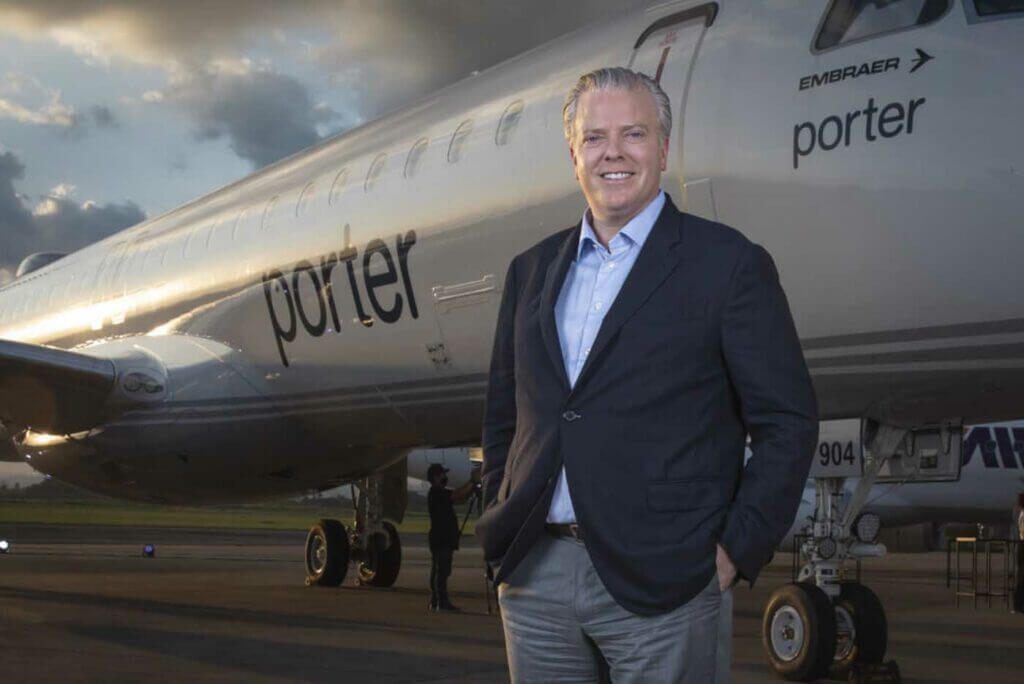
As the travel market recovered during 2022, key contestants like Air Canada, Air Transat, Sunwing, and WestJet (including Swoop, its ULCC subsidiary) reinstated aircraft to handle the surge of domestic and international traffic.
While it was wisely keeping its powder dry during the pandemic, Porter Airlines planned how it would take advantage of the pent-up demand for air travel once government-imposed restrictions were removed. Its fleet of turboprops would be reactivated, but the carrier had grander ambitions. Before discussing what came next, it is worth reviewing how Porter’s situation has evolved.
Enterprising Evolution
Porter Airlines began with a pair of Dash 8-400s operating between Billy Bishop Toronto City Airport (YTZ) and Ottawa in October 2006. Its premium in-flight service and convenient hub in the downtown core of Canada’s largest city earned the company accolades and passenger traffic. By the end of 2011, Porter was operating 26 turboprops year-round to 12 Canadian destinations between Thunder Bay, Ontario, and St. John’s, Newfoundland. As well, it was serving Boston, Chicago, and New York in the U.S. The carrier wanted to expand its route network across the continent, but required jets to do so.
In April 2013, Porter became the Canadian launch customer for the Bombardier CS100 jetliner when it ordered 12 units and took up options for an additional 18 aircraft. The orders were conditional on Porter receiving permission to operate the type out of YTZ, as well as getting runway 08/26 extended by almost 500 feet. However, in late 2015, the newly elected federal government said that jet airliners would not be allowed at YTZ. Porter’s expansion appeared to have been thwarted. Like “Mr. Porter,” its anthropomorphic raccoon mascot, the airline’s management team has shown itself to be clever and tenacious.
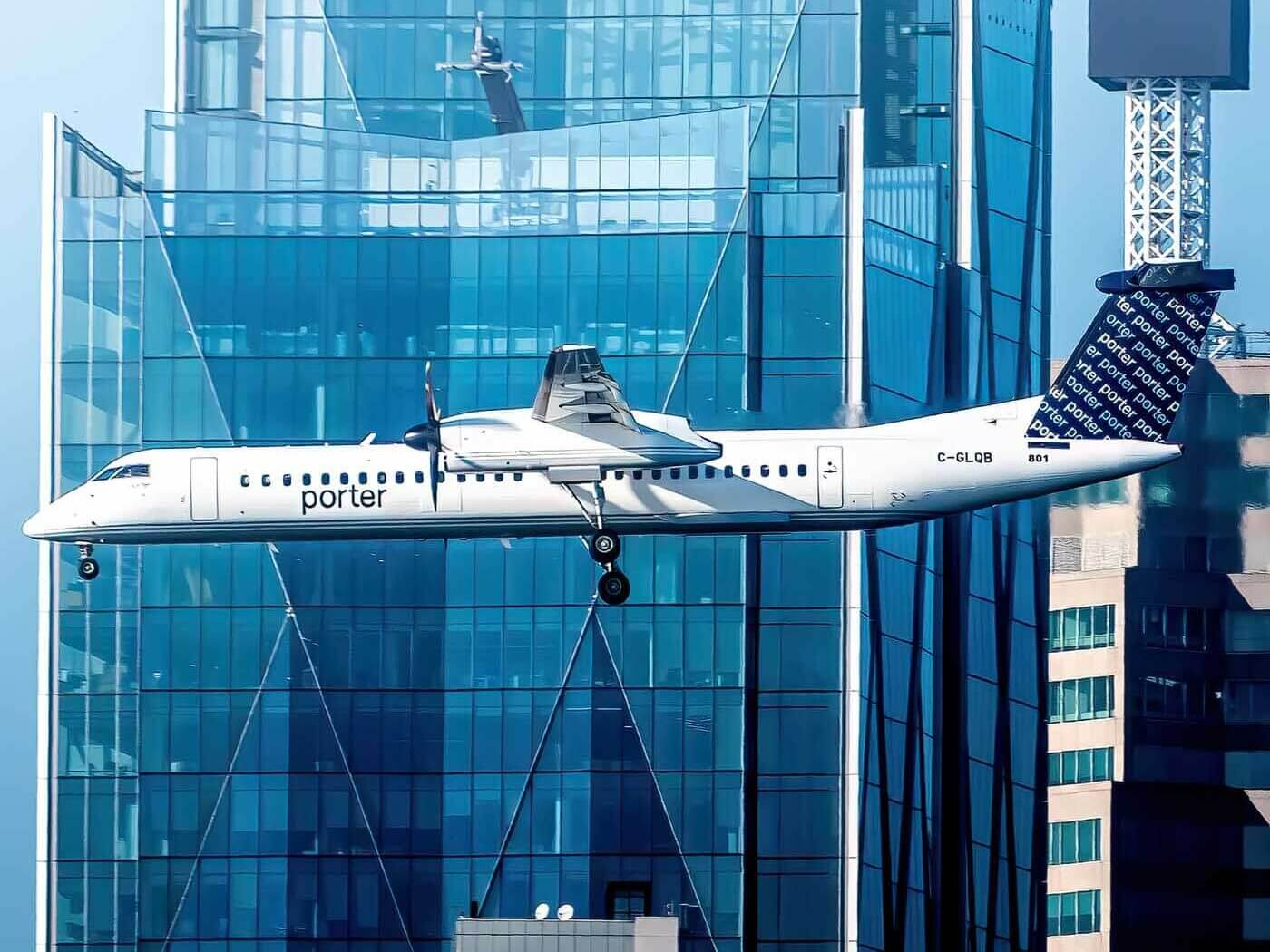
The Canadian airline industry was abuzz when Porter became the North American launch customer for the Embraer E195-E2 jet on July 12, 2021, and announced it would be operating out of Toronto Pearson Airport (YYZ) for the first time. The deal included a firm order for 30 aircraft and purchase rights for another 50. The following July, the firm order was increased to 50 aircraft. Based on the type’s list price, the 100 total aircraft have a value of approximately US$7.4 billion.
Porter’s jet operation is a bold venture. In order to see how it will differentiate itself from the competition, let’s take a closer look at the key features of the airline’s business plan.
Attractive Aircraft
The Embraer ERJ 190-400 STD, marketed as the E195-E2, is a twin jet airliner that normally accommodates up to 146 passengers. Porter’s planes are configured with 132 economy class seats, four abreast. The first two examples were delivered in December 2022. Since then, another seven have arrived at Toronto. Porter expects that 25 to 30 of the jets will be operating by the end of 2023 and that 50 should be in service a year later.
The cabin features three seating options: “PorterReserve,” which has four rows (16 seats) with a 36-inch pitch; “PorterClassic Stretch,” which has five rows (20 seats) with a 34-inch pitch; and “PorterClassic,” which has 24 rows (96 seats) with a 30-inch pitch.
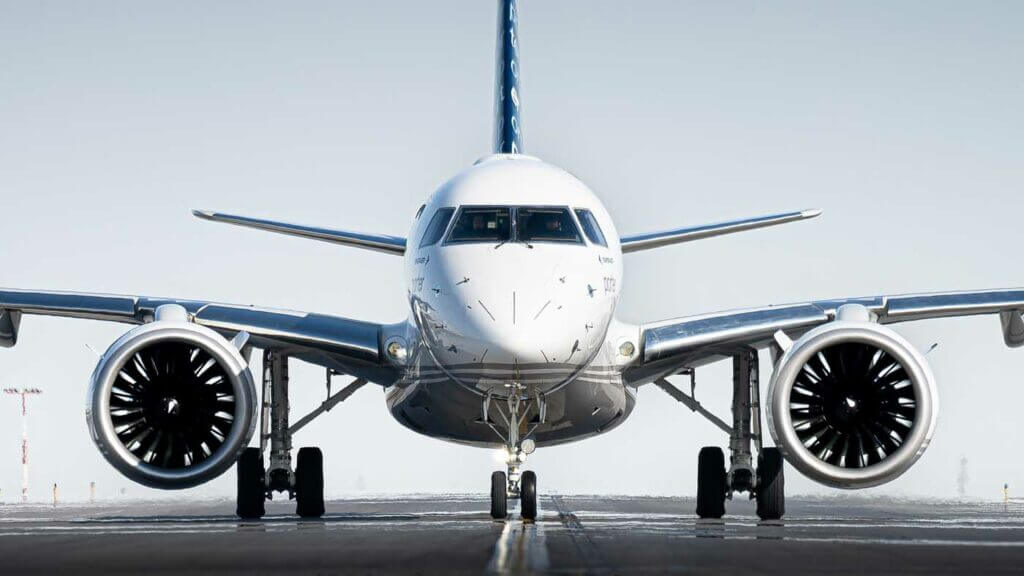
Equipped with Pratt & Whitney PW1900G geared turbofan (GTF) engines, the aircraft has a range of 2,500 nautical miles (4,630 kilometers) with 132 passengers aboard, and a maximum cruise speed of Mach .82.
Although some airlines that fly Pratt & Whitney GTF-powered aircraft have faced various operating challenges, Porter, so far, has not experienced such difficulties. The airline’s president and CEO, Michael Deluce, told Skies that “Pratt has been great to work with. They have a team that we meet with once a week, and they have individuals on site to make sure that everything goes smoothly.”
Having shown interest a decade ago in what is now the Airbus A220, why did Porter choose the Embraer E195-E2? Deluce said the aircraft’s fuel efficiency, range capability, and eco-friendliness (low emissions and small noise footprint) made it an attractive choice.
Another factor was the availability of the aircraft. Wanting to build up a meaningful fleet in a short period of time would not be possible with any competitive model.
It certainly doesn’t hurt that Porter is the North American launch customer for the type.
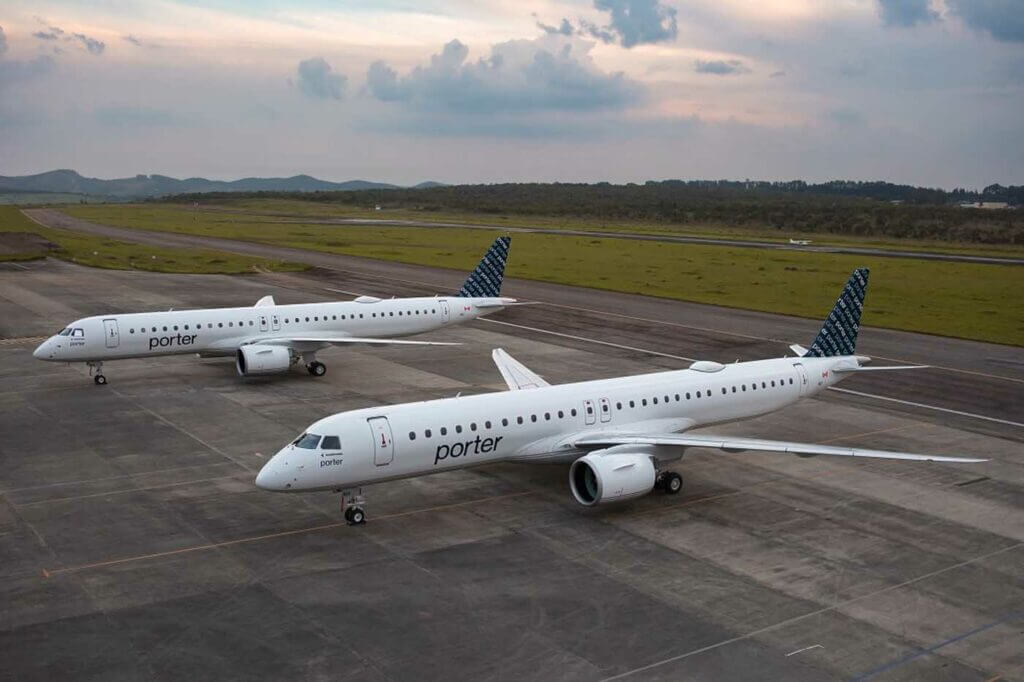
“North America is a large market for Embraer and Porter is a large customer,” Deluce told Skies. “Embraer is a wonderful company to work with. I can call the CEO and he would answer in one minute.”
Expanding Network
Porter initiated its jet operations on Feb. 1, 2023, with service from Toronto to Montreal and Ottawa. Later that month, E195-E2 service started from Toronto to Vancouver, Edmonton, and Calgary. The E195-E2s will eventually be operating from Toronto, Montreal, Ottawa, and Halifax to destinations across Canada and the United States.
Potential U.S. destinations include Las Vegas, Los Angeles, Miami, Phoenix, and San Francisco, and the airline is also considering adding service to Mexico and the Caribbean. Further, Porter’s jets may eventually be based at Western Canadian airports.
Growing Team
Porter currently has a team of roughly 2,500 personnel, which is about 1,300 more staff than its pre-pandemic level. However, more pilots, flight attendants, and aircraft maintenance engineers (AMEs) will be required for the new venture, and are to be sourced from both within Porter and outside the company — through flight schools, aviation colleges, and the industry’s most traditional source: competitors. Ultimately, the carrier expects to have 4,500 employees by the end of 2024.
In addition to providing industry-competitive salaries, Porter pays a bonus to its team members.
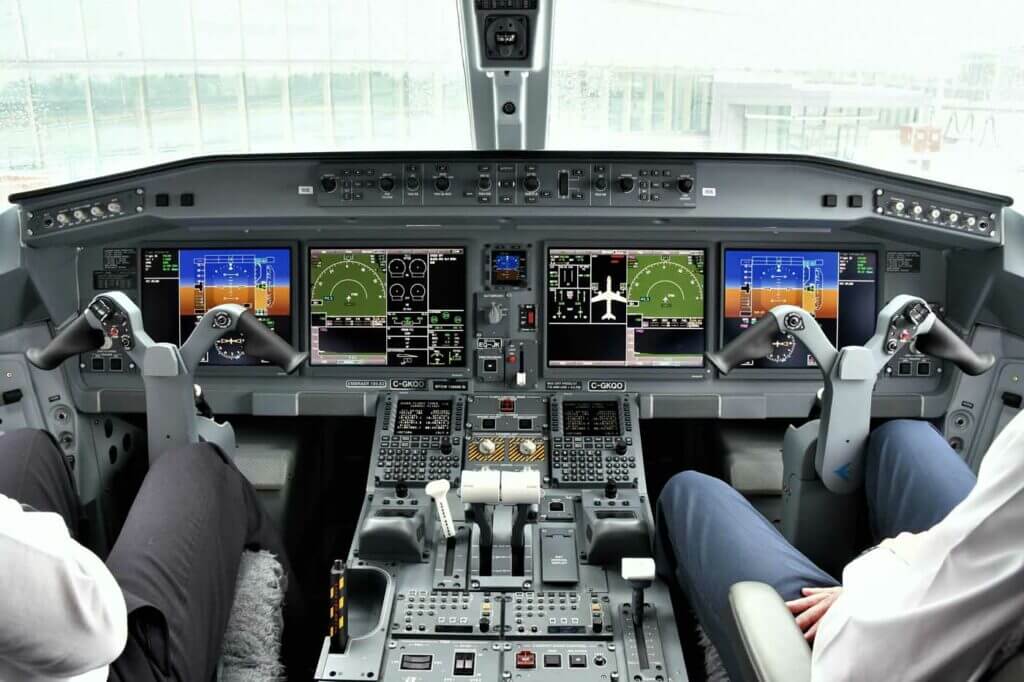
“The key success factor is our operational reliability,” explained Deluce. “So, we have an incentive program that is driven by key operating metrics.”
He also noted that Porter’s growth is providing career opportunities for individuals who wish to take on more responsibility.
New Facilities
At Montreal Saint-Hubert Airport (YHU) in Longueuil, Quebec — roughly 10 miles (16 km) east of downtown Montreal — Porter is building a new passenger terminal. Due to be completed by the end of 2024, it will handle four million passengers annually. Porter plans to operate both E195-E2s and Dash 8-400s there, but will also continue to operate out of Montreal-Trudeau Airport (YUL) — just west of Montreal’s downtown core in Dorval, Quebec.
Asked how this idea came about, Deluce said, “Knowing that Montreal is a key part of our overall growth plans, we’ve been looking at ways to differentiate Porter in the Montreal marketplace.” The strategy will result in Porter being the only Canadian scheduled carrier to operate at two airports at each of Canada’s two largest cities (Toronto and Montreal).
He added, “We extensively studied Saint-Hubert’s catchment area and there is a substantial portion of the population that will see drive-time savings, plus on-the-ground time savings at that airport.”
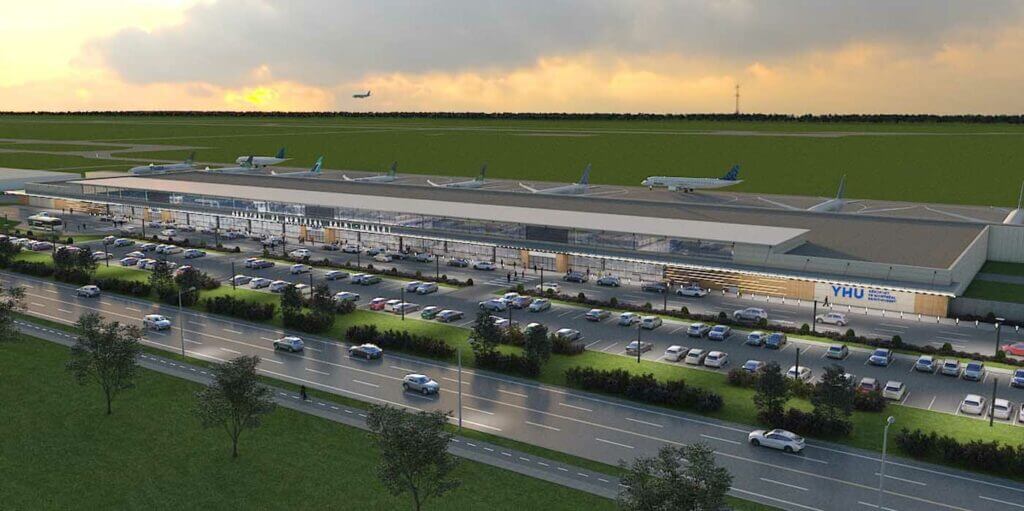
Porter is also investing in Ottawa International Airport (YOW), with plans to build two aircraft hangars for the maintenance of its Embraer jets and De Havilland turboprops. The 150,000-square-foot complex is expected to be completed by April 2024. Heavy maintenance on the jets will still be performed by Embraer at Nashville, Tennessee.
SWOT Analysis
In order to better understand any business model, and therefore appreciate how a company may fare in the future, it is helpful to perform a SWOT (strengths, weaknesses, opportunities, and threats) analysis. Doing so with Porter provides the following insights:
Strengths
One of Porter’s strengths is its reputation. The carrier’s “Flying Refined” brand reflects its focus on customer experience, including courteous service and the provision of quality food and beverages. Since its inception, Porter has received numerous travel industry awards for passenger satisfaction.
Another strength is its fleet. The Embraer E195-E2 provides excellent fuel efficiency and impressive range capability. Porter’s examples feature fast Wi-Fi, powered by Viasat, at no additional cost to the customer.
Deluce noted that the airplane’s two-by-two seat configuration is also important, as “we are the only airline in North America that does not have a middle seat.”
Lastly, Porter has a strong corporate culture. The airline has been able to attract and retain talented individuals because of its positive attitude toward its team members.
Weaknesses
One of Porter’s weaknesses is its low profile. While Porter is well known and respected in Eastern Canada, it will be working to become a familiar name west of Ontario and south of the border. So far, the new transcontinental services are generating an impressive level of originating traffic from Western Canada.
Another weakness is the fact that Porter is a private company. As a tightly held enterprise, Porter may not have the same access to financial resources as a public company. Nonetheless, it has done well in arranging lease financing for many of its new jets.
Opportunities
Porter’s new hub at Saint-Hubert offers one area of opportunity. Its jets and turboprops are to be deployed to destinations across Canada, from Vancouver to St. John’s. This new facility will enable the creation of many new city pairs for the convenience of Canada’s second-largest metropolitan market.
With its expanding network — thanks to its new Embraer jets — Porter will also have an opportunity to win domestic market share. Having never operated west of Ontario, Porter is offering its premium brand to Alberta and British Columbia for the first time.
Threats
An obvious threat to Porter is its competition. The two Canadian mainline carriers, Air Canada and WestJet, as well as newer ULCC players like Flair and Lynx, may use pricing as a weapon in an effort to retain market share. To be fair, Porter’s service offering does not compete directly with the Y-class products of its competitors.
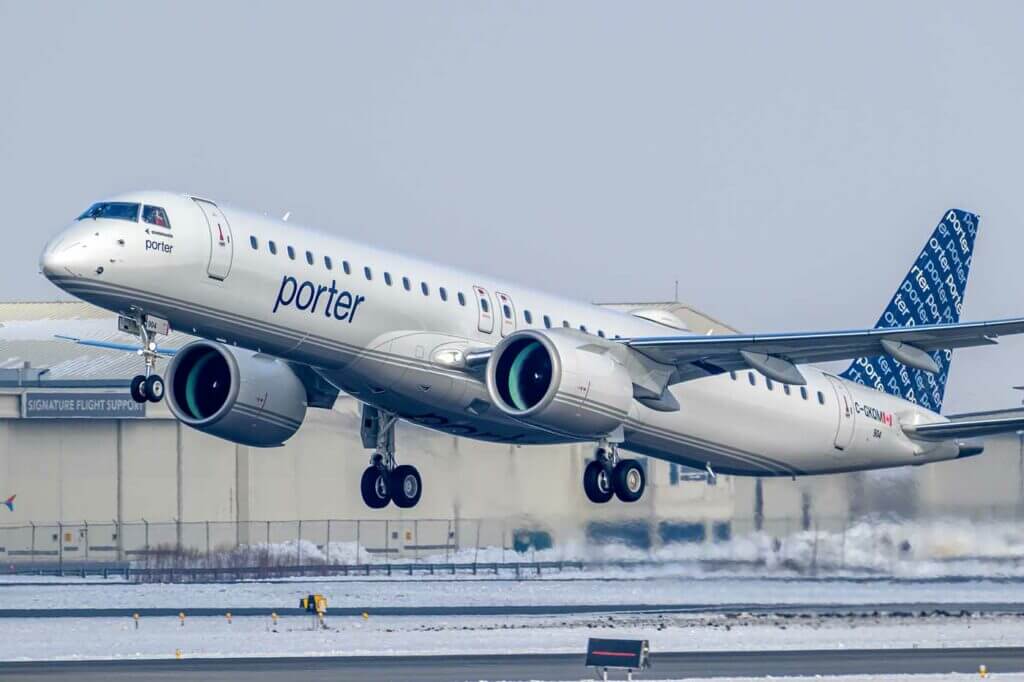
Another threat is the ongoing labor shortage. As the world’s population ages, the global airline industry is experiencing a shortage of pilots and AMEs. While not unique to Porter, the carrier may particularly struggle with this challenge as it seeks to hire roughly 2,000 new staff over the next year-and-a-half to support its growing fleet. However, Porter’s enviable reputation and its positive corporate culture have been most helpful in mitigating this situation thus far.
Final Words
The Canadian airline industry’s landscape has constantly been reshaped by economic, regulatory, and financial forces since it was deregulated on Jan. 1, 1988. Since then, many scheduled passenger carriers — like Canada 3000, CanJet, Intair, Jetsgo, Nationair, Royal Aviation, Zip, and Zoom, to name a few — have flown into history. Nonetheless, aviation is magnetic. It continues to attract entrepreneurs and capital.
With its growing fleet of Embraer E195-E2 jets and its well-respected service, Porter Airlines is well positioned to benefit from the travel industry’s resurgence.

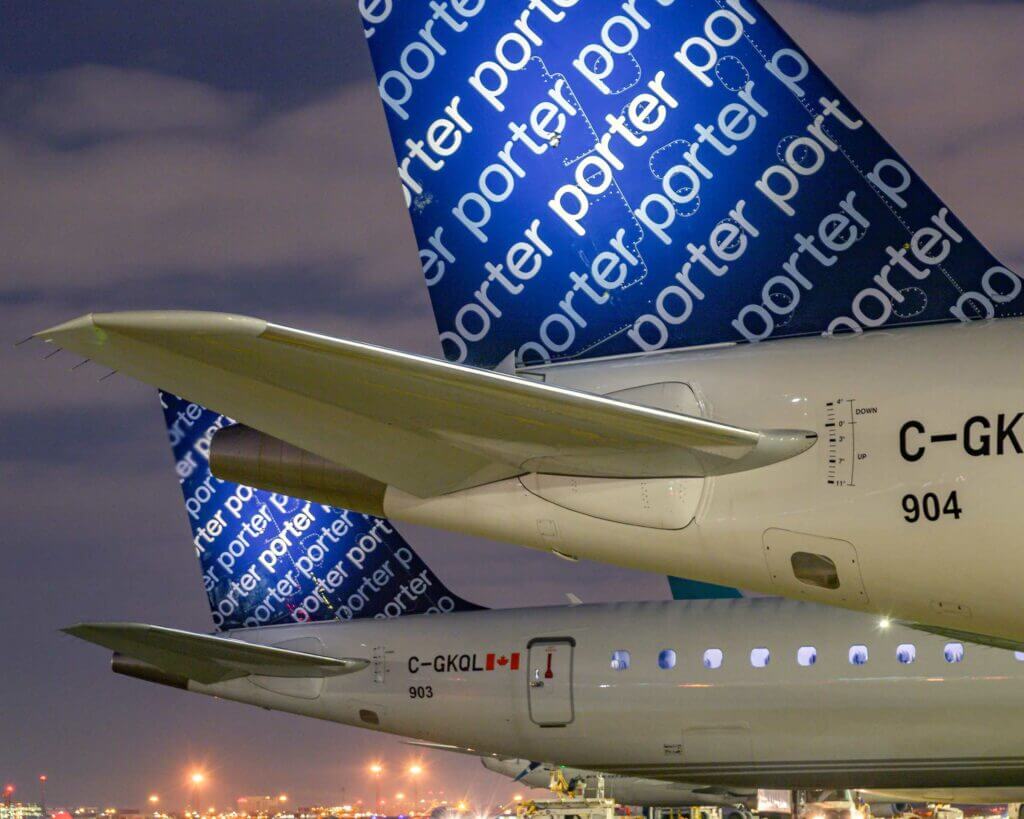




In your final words you missed one of the best and most beloved airlines in Canada,”Wardair”.Max Ward was one of the worlds best men that new how to run an airline and how to make people love that airline,a great shame that the carrier is no longer around as even today the service Wardair provided could not be beaten.
I wish Mr Deluce all the best for the future of his airline as it definitely seems to be heading in the right direction,we could use another notable carrier in Canada.
James McEwan
Thank you James for your comment. Max Ward was an admirable individual and an amazing entrepreneur. Wardair was not included in this list, as it was acquired by Canadian Airlines International. The carriers named flew into history as a result of financial difficulties.
Your right on Wardair it was a gem. Flew Calgary to Vancouver in am and got a full breakfast of eggs and bacon on china plates with real cutlery. Coffee was hot and service was unmatched. By touch down everything was ship, shape. Max you are missed.
Unfortunately these planes aren’t very pleasant to fly in for anything more than a couple of hours as it’s quite claustrophobic once you get on and you can tell it’s a regional jet when you get on (a stretched Regional jet is what it is). It’s Definitely inferior for anything 2+ hrs that it’s competitors fly who also have ife which porter doesn’t
Hi Rbran, thanks for taking the time to read the article. Porter’s new E195-E2 jets do not have IFE (in-flight entertainment) systems installed, by design. They are equipped with Viasat Wi-Fi systems that enable passengers to use their personal device to communicate with their family and friends, watch videos/movies and listen to music on their favourite entertainment platforms.
Can you please clarify what you mean when you say ( in the “Threats” section) “To be fair, Porter’s service offering does not compete directly with the Y-class products of its competitors. “. Are you insinuating that PD has a better economy product?
Also, I was wondering how you evaluate a corporate culture? In this case, you are making the argument that their “positive attitude toward its team members” is what’s driving this, but how do you know this?
Hi Mike, thanks for taking the time to read the article. Porter’s product is similar to other airlines’ premium economy or economy plus offerings. PD’s product includes food and beverage. It has been designed to not compete directly with the basic economy service provided by other domestic carriers. Porter’s “Flying Refined” marketing tagline implies its premium offering and its non-discount pricing.
A company’s culture can be estimated by reviewing its employee turnover, its ability to attract and retain talented individuals and by judging the attitude of its employees towards their customers, their workmates and their employer. Having dealt with numerous Porter team members, including recent recruits as well as those who have been around since the beginning, I believe that Porter’s corporate culture is a healthy one.
Cancelling at least 20% of their scheduled expansion flights in March is not the sign of smart expansion. An obvious weakness is not securing enough staffing and/or being able to train staff in time for promised flights on new routes.
The recent industry-wide growth has lead to competition for qualified personel and Porter most definitely over-estimated their ability to put people in place for a quick expansion. Instead of building on their solid reputation they are simply shooting themselves in the foot by disappointing customers.
I think what may have been one of Porter’s key strength was serving it’s Toronto hub from the Island airport. That was the key to the passenger experience compared to the oft-maligned Pearson experience. Despite reasonable seat pitch, the Dash 8 planes themselves are cramped, just like the new E2s are. This is an RJ, not a narrow body without the middle seat. The A220 would have delivered a better customer experience. So let’s be honest… It was just about the aircraft availability to meet his growth plans, it was not about passenger experience as you are dumping into misery at Pearson and squeezing into a cramped plane.
You are forgetting a very important point here that Porter caters to the economy air travel market, not the luxury market!